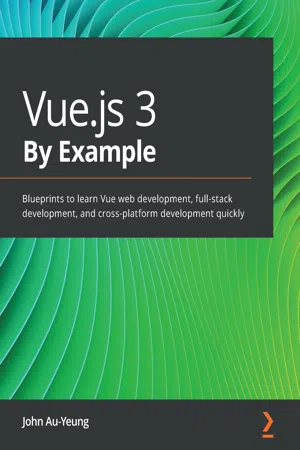
Vue.js 3 By Example
Blueprints to learn Vue web development, full-stack development, and cross-platform development quickly
- 320 pages
- English
- ePUB (mobile friendly)
- Available on iOS & Android
Vue.js 3 By Example
Blueprints to learn Vue web development, full-stack development, and cross-platform development quickly
About this book
Kick-start your Vue.js development career by learning the fundamentals of Vue 3 and its integration with modern web technologies such as Electron, GraphQL, Ionic, and Laravel
Key Features
- Download complete source code for all Vue.js projects built throughout the book
- Discover steps to build production-ready Vue.js apps across web, mobile, and desktop
- Build a compelling portfolio of web apps, including shopping cart system, booking app, slider puzzle game, real-time chat app, and more
Book Description
With its huge ecosystem and wide adoption, Vue is one of the leading frameworks thanks to its ease of use when developing applications. However, it can get challenging for aspiring Vue.js developers to make sense of the ecosystem and build meaningful applications.
This book will help you understand how you can leverage Vue effectively to develop impressive apps quickly using its latest version – Vue 3.0.
The book takes an example-based approach to help you get to grips with the basics of Vue 3 and create a simple application by exploring features such as components and directives. You'll then enhance your app building skills by learning how to test the app with Jest and Vue Test Utils. As you advance, you'll understand how to write non-web apps with Vue 3, create cross-platform desktop apps with the Electron plugin, and build a multi-purpose mobile app with Vue and Ionic. You'll also be able to develop web apps with Vue 3 that interact well with GraphQL APIs. Finally, you'll build a chat app that performs real-time communication using Vue 3 and Laravel.
By the end of this Vue.js book, you'll have developed the skills you need to build real-world apps using Vue 3 by working through a range of projects.
What you will learn
- Get to grips with Vue architecture, components, props, directives, mixins, and other advanced features
- Understand the Vue 3 template system and use directives
- Use third-party libraries such as Vue Router for routing and Vuex for state management
- Create GraphQL APIs to power your Vue 3 web apps
- Build cross-platform Vue 3 apps with Electron and Ionic
- Make your Vue 3 apps more captivating with PrimeVue
- Build real-time communication apps with Vue 3 as the frontend and Laravel
Who this book is for
This book is for web developers who want to learn frontend web development with Vue 3 and use it to create professional applications. You'll also find this book useful if you're looking to create full-stack web apps with Vue.js 3.0 as the frontend. Knowledge of JavaScript programming is required to get the most out of this book.
Frequently asked questions
- Essential is ideal for learners and professionals who enjoy exploring a wide range of subjects. Access the Essential Library with 800,000+ trusted titles and best-sellers across business, personal growth, and the humanities. Includes unlimited reading time and Standard Read Aloud voice.
- Complete: Perfect for advanced learners and researchers needing full, unrestricted access. Unlock 1.4M+ books across hundreds of subjects, including academic and specialized titles. The Complete Plan also includes advanced features like Premium Read Aloud and Research Assistant.
Please note we cannot support devices running on iOS 13 and Android 7 or earlier. Learn more about using the app.
Information
Chapter 1: Creating Your First Application in Vue 3
- Understanding Vue as a framework
- Setting up the Vue project
- Vue 3 core features – components and built-in directives
- Debugging with Vue.js Devtools
Technical requirements
Understanding Vue as a framework
Setting up the Vue project with the Vue CLI and script tag
Table of contents
- Vue.js 3 By Example
- Contributors
- Preface
- Chapter 1: Creating Your First Application in Vue 3
- Chapter 2: Building a Vue 3 Progressive Web App
- Chapter 3: Building a Slider Puzzle Game with Tests
- Chapter 4: Building a Photo Management Desktop App
- Chapter 5: Building a Multipurpose Calculator Mobile App with Ionic
- Chapter 6: Building a Vacation Booking App with the PrimeVue UI Framework
- Chapter 7: Creating a Shopping Cart System with GraphQL
- Chapter 8: Building a Chat App with Vue 3, Laravel, and Socket.IO
- Other Books You May Enjoy